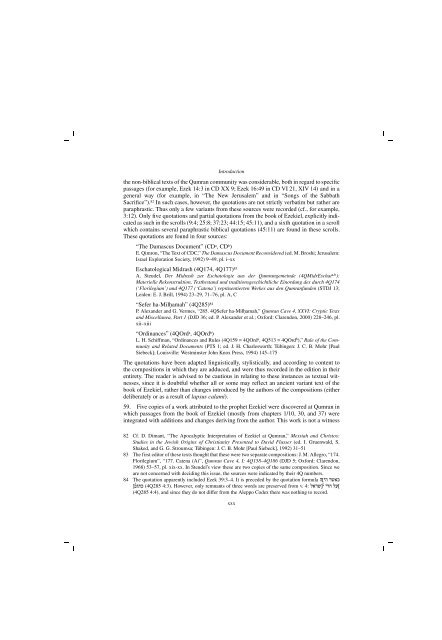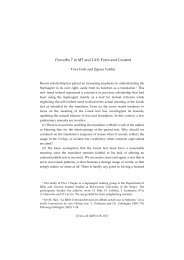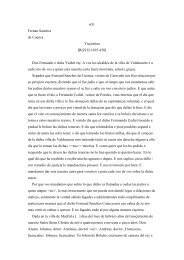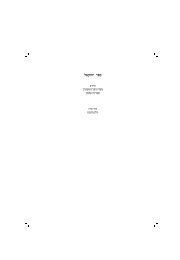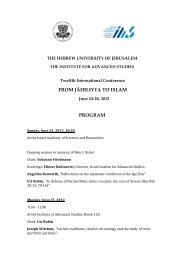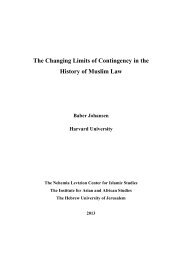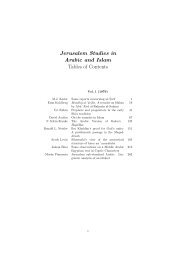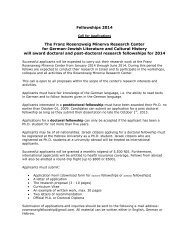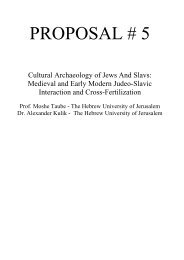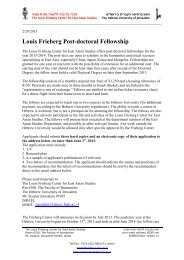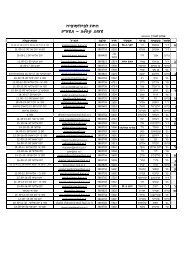THE BOOK OF EZEKIEL Moshe H. Goshen-Gottstein Shemaryahu ...
THE BOOK OF EZEKIEL Moshe H. Goshen-Gottstein Shemaryahu ...
THE BOOK OF EZEKIEL Moshe H. Goshen-Gottstein Shemaryahu ...
You also want an ePaper? Increase the reach of your titles
YUMPU automatically turns print PDFs into web optimized ePapers that Google loves.
Introduction<br />
the non-biblical texts of the Qumran community was considerable, both in regard to specific<br />
passages (for example, Ezek 14:3 in CD XX 9; Ezek 16:49 in CD VI 21, XIV 14) and in a<br />
general way (for example, in “The New Jerusalem” and in “Songs of the Sabbath<br />
Sacrifice”). 82 In such cases, however, the quotations are not strictly verbatim but rather are<br />
paraphrastic. Thus only a few variants from these sources were recorded (cf., for example,<br />
3:12). Only five quotations and partial quotations from the book of Ezekiel, explicitly indicated<br />
as such in the scrolls (9:4; 25:8; 37:23; 44:15; 45:11), and a sixth quotation in a scroll<br />
which contains several paraphrastic biblical quotations (45:11) are found in these scrolls.<br />
These quotations are found in four sources:<br />
“The Damascus Document” (CD a , CD b )<br />
E. Qimron, “The Text of CDC,” The Damascus Document Reconsidered (ed. M. Broshi; Jerusalem:<br />
Israel Exploration Society, 1992) 9–49, pl. i–xx<br />
Eschatological Midrash (4Q174, 4Q177) 83<br />
A. Steudel, Der Midrash zur Eschatologie aus der Qumrangemeinde (4QMidrEschat a,b ):<br />
Materielle Rekonstruktion, Textbestand und traditionsgeschichtliche Einordung des durch 4Q174<br />
(‘Florilegium’) und 4Q177 (‘Catena’) reprasentierten ¨ Werkes aus den Qumranfunden (STDJ 13;<br />
Leiden: E. J. Brill, 1994) 23–29, 71–76, pl. A, C<br />
“Sefer ha-Milhamah” . (4Q285) 84<br />
P. Alexander and G. Vermes, “285. 4QSefer ha-Milhamah,” . Qumran Cave 4, XXVI: Cryptic Texts<br />
and Miscellanea, Part 1 (DJD 36; ed. P. Alexander et al.; Oxford: Clarendon, 2000) 228–246, pl.<br />
xii–xiii<br />
“Ordinances” (4QOrd a , 4QOrd b )<br />
L. H. Schiffman, “Ordinances and Rules (4Q159 = 4QOrd a , 4Q513 = 4QOrd b ),” Rule of the Community<br />
and Related Documents (PTS 1; ed. J. H. Charlesworth; Tubingen: ¨ J. C. B. Mohr [Paul<br />
Siebeck]; Louisville: Westminster John Knox Press, 1994) 145–175<br />
The quotations have been adapted linguistically, stylistically, and according to content to<br />
the compositions in which they are adduced, and were thus recorded in the edition in their<br />
entirety. The reader is advised to be cautious in relating to these instances as textual witnesses,<br />
since it is doubtful whether all or some may reflect an ancient variant text of the<br />
book of Ezekiel, rather than changes introduced by the authors of the compositions (either<br />
deliberately or as a result of lapsus calami).<br />
59. Five copies of a work attributed to the prophet Ezekiel were discovered at Qumran in<br />
which passages from the book of Ezekiel (mostly from chapters 1/10, 30, and 37) were<br />
integrated with additions and changes deriving from the author. This work is not a witness<br />
82 Cf. D. Dimant, “The Apocalyptic Interpretation of Ezekiel at Qumran,” Messiah and Christos:<br />
Studies in the Jewish Origins of Christianity Presented to David Flusser (ed. I. Gruenwald, S.<br />
Shaked, and G. G. Stroumsa; Tubingen: ¨ J. C. B. Mohr [Paul Siebeck], 1992) 31–51<br />
83 The first editor of these texts thought that these were two separate compositions: J. M. Allegro, “174.<br />
Florilegium”, “177. Catena (A)”, Qumran Cave 4, I: 4Q158–4Q186 (DJD 5; Oxford: Clarendon,<br />
1968) 53–57, pl. xix-xx. In Steudel’s view these are two copies of the same composition. Since we<br />
are not concerned with deciding this issue, the sources were indicated by their 4Q numbers.<br />
84 The quotation apparently included Ezek 39:3–4. It is preceded by the quotation formula d[id xy`k<br />
]aezk Ç (4Q285 4:3). However, only remnants of three words are preserved from v. 4: l`xy]i Ç ˙ixd lr[<br />
(4Q285 4:4), and since they do not differ from the Aleppo Codex there was nothing to record.<br />
xxx


